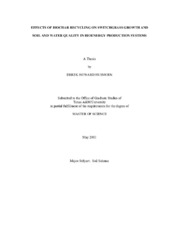| dc.description.abstract | Intensive biomass production in emerging bioenergy systems could increase nonpoint-source sediment and nutrient losses and impair surface and groundwater quality. Recycling biochar, a charcoal byproduct from pyrolysis of biomass, provides potential sources of mineral nutrients and organic carbon for sustaining biomass productivity and preserving soil and water. Yet, research is needed to verify that recycling of pyrolysis biochars will enhance crop growth and soil and environmental quality similar to black carbon or biochar derived from burning of biomass in tropical or Terra Preta soils. The experimental design of this study consisted of 3 replications and four biochar rates (0, 4, 16, and 64 Mg ha-1) incorporated in both a sandy loam and clay soil with and without fertilizer sources of N, P, and K. The sandy loam and clay soils were studied in separate experiments within a set of 24 box lysimeters seeded with switchgrass. Simulated rain was applied at 50 percent and 100 percent establishment of switchgrass for each soil type. Runoff and leachate were collected and analyzed for total and dissolved N, P, K and organic C. After the second rain event, each soil type and the accumulated switchgrass was sampled and analyzed.
In the Boonville soil, biochar applied at 64 Mg ha-1 decreased switchgrass emergence from 42 percent to 14 percent when compared to soil alone. In the Burleson soil, 64 Mg ha-1 biochar had no effect (P > 0.05) on biomass production or leaf area index (LAI). Fertilizer N, P, and K had no effect (P > 0.05) on switchgrass emergence for either soil, but did increase (P < 0.001) N, P, and K uptake, biomass production, and LAI. Increasing rates of biochar increased (P < 0.001) runoff concentrations of DRP during each rain event for both the Boonville and Burleson soils. Four rates of biochar receiving supplemental N, P, and K fertilizer also resulted in greater runoff concentrations of DRP. Emergence tests under increased heat showed electrical conductivities of soil-water solutions to be as high as 600 microS cm-1, even after biochar was washed with acetone and water to remove residual oils and tars and soluble salts.
Increasing biochar rates decreased soil bulk density and increased pH and SOC in the 0- to 5-cm depth of soil. As a result of high nutrient recovery during pyrolysis (58 percent of total N, 86 percent of total P and 101 percent of total K), high rates of biochar applied at 64 Mg ha-1 increased mass losses of TN, TP, and TK from both soils. Yet, the mass balance of nutrients showed a surplus of N, P, and K at 64 Mg ha-1 biochar, which suggests some nutrient inputs are not plant available and remain in soil. Careful management of biochar, especially at high rates with these high nutrient contents, is critical when trying to improve soil fertility while protecting water quality. | en |


